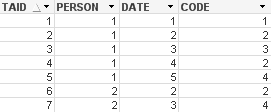Unlock a world of possibilities! Login now and discover the exclusive benefits awaiting you.
- Qlik Community
- :
- All Forums
- :
- QlikView App Dev
- :
- Re: Counting transactions after event
- Subscribe to RSS Feed
- Mark Topic as New
- Mark Topic as Read
- Float this Topic for Current User
- Bookmark
- Subscribe
- Mute
- Printer Friendly Page
- Mark as New
- Bookmark
- Subscribe
- Mute
- Subscribe to RSS Feed
- Permalink
- Report Inappropriate Content
Counting transactions after event
Hi community,
I would like to count the numnber of transactions occuring after a specific event for each person.
The data looks like this:

The event of interest is entered as a variable (v_Code). So if i enter 2 as event in v_code, i would like to have a result like this:
Person Number of Transactions after Code=2 (TAID)
1 3
2 1
Does anybody know how to solve this? I guess set-analysis is not possible. I tried asof-Tables, but cannot create them because of size (3 million transactions in table).
Any help appreciated.
Cheers Andreas.
- Tags:
- new_to_qlikview
- « Previous Replies
-
- 1
- 2
- Next Replies »
Accepted Solutions
- Mark as New
- Bookmark
- Subscribe
- Mute
- Subscribe to RSS Feed
- Permalink
- Report Inappropriate Content
Second expression seems to work ok also for v_Code = 1, just need to use the correct field names (QV is case sensitive):
=Count( AGGR( if( TAID > MIN(TOTAL<PERSON> {<CODE = {'$(v_Code)'}>} TAID), TAID), PERSON, TAID))
- Mark as New
- Bookmark
- Subscribe
- Mute
- Subscribe to RSS Feed
- Permalink
- Report Inappropriate Content
May be this:
Dimesnion: PERSON
Expression: =Count({<CODE = {"$(='>' & $(v_Code))"}>}PERSON) or may be this:
=Count(If(CODE > $(v_Code), PERSON))
- Mark as New
- Bookmark
- Subscribe
- Mute
- Subscribe to RSS Feed
- Permalink
- Report Inappropriate Content
Thanks Sunny,
I tried it. Seems to work but only if a code is used that both Persons received. For example if i enter 1 for v_code it correctly returns 4 for Person 1 but also 2 for Person 2 although this Person hasn't received Code 1 at all.
Cheers
Andreas
- Mark as New
- Bookmark
- Subscribe
- Mute
- Subscribe to RSS Feed
- Permalink
- Report Inappropriate Content
try with Dimension Person with following expression:
Exp: count({<CODE={'>=$(=v_Code)'}>} Person)
make sure CODE should be in num format
- Mark as New
- Bookmark
- Subscribe
- Mute
- Subscribe to RSS Feed
- Permalink
- Report Inappropriate Content
Or maybe
Dimension: Person
Expression: =Count({<CODE = {">=$(v_Code)"}>} TAID) -1
or
Expression:
=Count( AGGR( if( TAID > MIN(TOTAL<Person> {<Code = {'$(v_Code)'}>} TAID), TAID), PERSON, TAID))
edit: It's not really clear if Code of a TAID could be any Code, even lower than the previous codes and the code you are looking for. It seems that could be the case and that you just want to count any TAID after the first occurence of vCode, sorted by TAID. I believe, you would need something like my second expression then.
- Mark as New
- Bookmark
- Subscribe
- Mute
- Subscribe to RSS Feed
- Permalink
- Report Inappropriate Content
Create straight table
Dimension : Person
Expression : count({<Code ={"$(=v_Code)"}>}Person)
- Mark as New
- Bookmark
- Subscribe
- Mute
- Subscribe to RSS Feed
- Permalink
- Report Inappropriate Content
Thanks swuehl,
you are right, the codes are ordered by chance in the example. It is possible, that they are not ordered, so that a >= comparison would fail.
I tried your second solution, but it doesn't return anything.
Edit: Found it Person for TOTAL has to be also in upper case. But it is still not working. For code=2 it returns for Person1 4 and for Person2 = 1. Any idea why?
- Mark as New
- Bookmark
- Subscribe
- Mute
- Subscribe to RSS Feed
- Permalink
- Report Inappropriate Content
Second expression seems to work ok also for v_Code = 1, just need to use the correct field names (QV is case sensitive):
=Count( AGGR( if( TAID > MIN(TOTAL<PERSON> {<CODE = {'$(v_Code)'}>} TAID), TAID), PERSON, TAID))
- Mark as New
- Bookmark
- Subscribe
- Mute
- Subscribe to RSS Feed
- Permalink
- Report Inappropriate Content
What do you expect to see when you v_Code = 1 for person 2?
- Mark as New
- Bookmark
- Subscribe
- Mute
- Subscribe to RSS Feed
- Permalink
- Report Inappropriate Content
It should be empty, because Person 2 didn't receive code 1.
Edit: Thanks Sunny. See answer of swuehl
- « Previous Replies
-
- 1
- 2
- Next Replies »